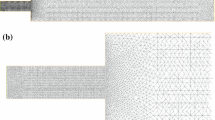Abstract
The use of translation invariant cost functionals for the reduction of vortices in the context of shape optimization of fluid flow domains is investigated. Analytical expressions for the shape design sensitivity involving different cost functionals are derived. Instationary channel flow problems with a bump and an obstacle as possible control boundaries are taken as test examples. Numerical results are provided in various graphical forms for relatively low Reynolds numbers. Striking differences are found for the optimal shapes corresponding to the different cost functionals, which constitute different quantification of a vortex.















Similar content being viewed by others
References
Bach, M., Constanda, C., Hsiao, G.C., Sandig, A.M., Werner, P.: Analysis, Numerics and Applications of Differential and Integral Equations. Research Notes in Mathematics Series, vol. 379. Addison–Wesley/Longman, Reading/Harlow (1998)
Delfour, M.C., Zolésio, J.P.: Shapes and Geometries: Analysis, Differential Calculus, and Optimization. Society for Industrial and Applied Mathematics, Philadelphia (2001)
Evans, L.C.: Partial Differential Equations. American Mathematical Society, Providence (1998)
Gao, Z., Ma, Y.: Shape gradient of the dissipated energy functional in shape optimization for the viscous incompressible flow. Appl. Numer. Math. 58(11), 1720–1741 (2008)
Gao, Z., Ma, Y.: Shape optimization in time-dependent Navier-Stokes flows via function space parametrization technique. Comput. Model. Eng. Sci. 66(2), 135–163 (2010)
Gunzburger, M.D.: Perspectives in Flow Control and Optimization. Society for Industrial and Applied Mathematics, Philadelphia (2002)
Halanay1, A., Tiba, D.: Shape optimization for stationary Navier-Stokes equations. Control Cybern. 38(4B) (2009)
Haslinger, J., Mäkinen, R.A.E.: Introduction to Shape Optimization: Theory, Approximation, and Computation. Society for Industrial and Applied Mathematics, Philadelphia (2003)
He, B., Ghattas, O., Antaki, J.F.: Computational strategies for shape optimization of Navier-Stokes flows. Technical report CMU-CML-97-102, Computational Mechanics Lab, Department of Civil and Environmental Engineering, Carnegie Mellon University (1997)
Henrot, A., Privat, Y.: What is the optimal shape of a pipe? Arch. Ration. Mech. Anal. 196(1), 281–302 (2009)
Heywood, J.G., Rannacher, R., Turek, S.: Artificial boundaries and flux and pressure conditions for the incompressible Navier-Stokes equations. Int. J. Numer. Methods Fluids 22(5), 325–352 (1996)
Ito, K., Kunisch, K., Peichl, G.: Variational approach to shape derivatives for a class of Bernoulli problems. J. Math. Anal. Appl. 314(1), 126–149 (2006)
Ito, K., Kunisch, K., Peichl, G.: Variational approach to shape derivatives. In: ESAIM: Control, Optimisation and Calculus of Variations, vol. 14, pp. 517–539 (2008)
Kasumba, H., Kunisch, K.: On shape sensitivity analysis of the cost functional without shape sensitivity of the state variable. Control Cybern. 40(4), 989–1017 (2011)
Kasumba, H., Kunisch, K.: Vortex control in channel flows using translational invariant cost functionals. Comput. Optim. Appl. (2011). doi:10.1007/s10589-011-9434-y
Kunisch, K., Vexler, B.: Optimal vortex reduction for instationary flows based on translation invariant cost functionals. SIAM J. Control Optim. 46(4), 1368–1397 (2007)
Quarteroni, A., Valli, A.: Numerical Approximation of Partial Differential Equations. Springer, Berlin (1997)
Sokolowski, J., Zolésio, J.P.: Introduction to Shape Optimization. Shape Sensitivity Analysis. Springer, Berlin (1992)
Author information
Authors and Affiliations
Corresponding author
Rights and permissions
About this article
Cite this article
Kasumba, H., Kunisch, K. Vortex control of instationary channel flows using translation invariant cost functionals. Comput Optim Appl 55, 227–263 (2013). https://doi.org/10.1007/s10589-012-9516-5
Received:
Published:
Issue Date:
DOI: https://doi.org/10.1007/s10589-012-9516-5




